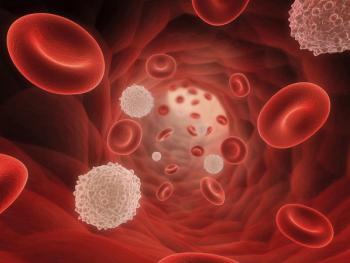
Oncology NEWS International
- Oncology NEWS International Vol 10 No 2
- Volume 10
- Issue 2
Dose-Intensified Chemotherapy Does Not Improve Outcome in Non-Hodgkin’s Lymphoma
EAST MELBOURNE, Australia-Dose-intensified CEOP (cyclophosphamide, epirubicin, Oncovin [vincristine], prednisolone) produces significantly more toxicity than a standard dose CEOP regimen (s-CEOP), but does not improve outcome in non-Hodgkin’s lymphoma patients, according to a phase-III trial conducted in Australia and New Zealand by the Australian Leukemia and Lymphoma Group (ALLG).
EAST MELBOURNE, AustraliaDose-intensified CEOP (cyclophosphamide, epirubicin, Oncovin [vincristine], prednisolone) produces significantly more toxicity than a standard dose CEOP regimen (s-CEOP), but does not improve outcome in non-Hodgkin’s lymphoma patients, according to a phase-III trial conducted in Australia and New Zealand by the Australian Leukemia and Lymphoma Group (ALLG).
Although the dose in the intensified CEOP (i-CEOP) group was 78% higher than in the standard dose group, the overall response rate of both groups was 83%. The complete response/complete response unconfirmed rate was not significantly different, either59% for the standard CEOP regimen and 53% for the intensified CEOP therapy.
Begun in 1994, the trial followed 247 patients for a median of 3 years, but at least 12 months. The two groups of patients were similar in their disease characteristics. The median age of the patients was 53 years, and 39% had stage IV disease. Sixty- nine percent of the study participants had diffuse large cell or immunoblastic histology.
In the s-CEOP arm, patients received 750 mg/m2 IV of cyclophosphamide, 75 mg/m2 IV of epirubicin, 1.4 mg/m2 IV of vincristine, all on day 1, and 100 mg/d of prednisolone on days 1-5. The i-CEOP regimen consisted of 1,500 mg/m2 of cyclophosphamide and 150 mg/m2 of epirubicin, plus the same dose of vincristine and prednisolone as in the s-CEOP therapy. The i-CEOP patients also received 5 µg/kg/d of filgrastim (Neupogen) from day 2.
The regimens were administered for six cycles, every 21 days.
When the two arms were compared, the estimated 5-year failure- free survival for the i-CEOP patients was 42% vs 47% for the s-CEOP patients. "Despite the increase in dose intensity, there was no real difference in outcome between the two groups," said lead researcher Max Wolf, MD, of Peter MacCallum Cancer Institute in East Melbourne, Australia.
Significantly More Toxic
The study also revealed that there was significantly more toxicity in the i-CEOP arm, including more anemia, infections, and neutropenia and thrombocytopenia. A greater number of platelet and red blood cell transfusions were necessary in i-CEOP patients. Febrile neutropenia, for instance, occurred in 70% of patients on i-CEOP therapy vs 26% of patients on the s-CEOP regimen. Severe cardiac toxicity was reported in 5% of i-CEOP patients and 2% of s-CEOP patients. Thirteen percent of patients on i-CEOP had to quit the study because of significant toxicity vs 3% on s-CEOP.
There were also four toxic deaths on i-CEOP and two on s-CEOP. Statistical calculations by the researchers revealed that the death rate for i-CEOP relative to s-CEOP patients was 0.996. For intermediate/high-risk patients, the comparative estimated death rate was 0.958.
Previous studies had shown that dose reductions in CHOP (cyclophosphamide, doxorubicin, Oncovin [vincristine], prednisone) resulted in adverse outcomes, Dr. Wolf said. Such studies also seemed to suggest that dose intensity was important in non-Hodgkin’s lymphoma outcomes, and might even improve results.
"Yet when we compared intensified with standard therapy, we did not witness any difference in remission rates or survival," Dr. Wolf said. "And we certainly did see greater toxicity with the intensified therapy."
Articles in this issue
almost 25 years ago
Activated T Cells Can Alter Behavior of Leukemic B Cellsalmost 25 years ago
Response Continues for at Least 8 Months with Ibritumomab Tiuxetanalmost 25 years ago
Synthetic Anthracycline Produces High Response Rates in SCLCalmost 25 years ago
Ibritumomab Tiuxetan Produces 73% Response Rate in B-cell NHLalmost 25 years ago
G-CSF Might Prolong Rituximab Responses in NHLalmost 25 years ago
Use of CAD Increases the Early Detection of Breast Cancer by 20%almost 25 years ago
Rituximab Plus Fludarabine May Be Good Alternative to Rituximab Plus CHOPNewsletter
Stay up to date on recent advances in the multidisciplinary approach to cancer.

















































































